MERCEDES-BENZ S-CLASS CABRIOLET 2018 Owner's Manual
Manufacturer: MERCEDES-BENZ, Model Year: 2018, Model line: S-CLASS CABRIOLET, Model: MERCEDES-BENZ S-CLASS CABRIOLET 2018Pages: 502, PDF Size: 6.27 MB
Page 161 of 502
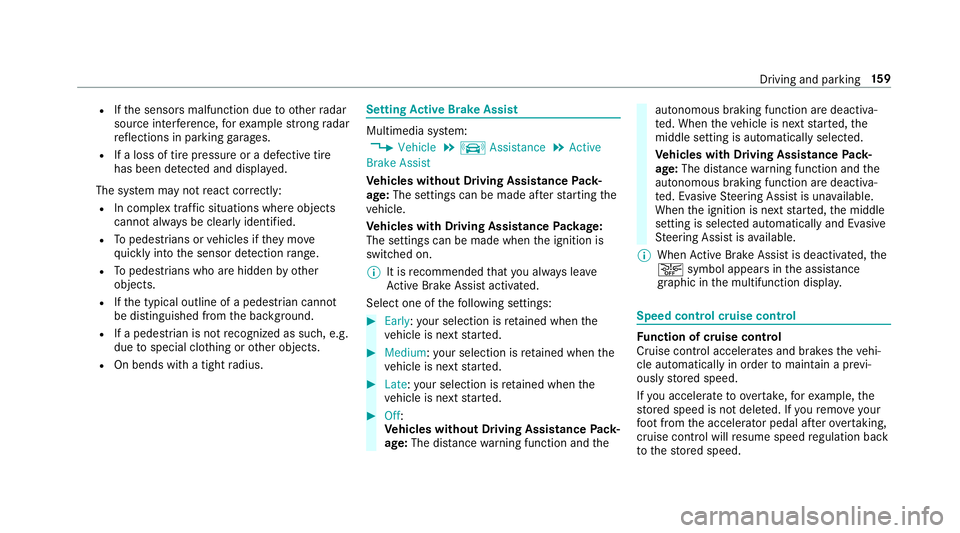
RIfth e sensors malfunction due to otherradar
source inter fere nce, forex ample strongradar
re flections in parking garage s.
RIf a loss of tire pressure or a defective tire
has been de tected and displ ayed.
The sy stem may not react cor rectly:
RIn complex traffic situations whe reobjects
cannot always be clearly identified.
RTo pedestrians or vehicles if they mo ve
qu ickly into the sensor de tection range.
RTo pedestrians who are hidden by other
objects.
RIf th e typical outline of a pedestrian cannot
be distinguished from the bac kground.
RIfa pedestrian isnot recognized as such , e.g.
due tospecial clo thing or other objects.
ROn bends with a tight radius.
Setting Active Brake Assi st
Multimedia system:
,Vehicle.k Assistance.Active
Brake Assist
Ve hicles without Driving Assistance Pack‐
age: The settings can be made af terst arting the
ve hicle.
Ve hicles with Driving Assistance Package:
The settings can be made when the ignition is
switched on.
% It is recommended that you alw ays lea ve
Ac tive Brake Assi stactivated.
Select one of thefo llowing settings:
#Early :yo ur selection isretained when the
ve hicle is next star ted.
#Medium :yo ur selection isretained when the
ve hicle is next star ted.
#Late: your selection isretained when the
ve hicle is next star ted.
#Off:
Ve hicles without Driving Assistance Pack‐
age: The dis tance warning function and the
autonomous braking function are deactiva‐
ted. When theve hicle is next star ted, the
middle setting is auto matically selected.
Ve hicles with Driving Assistance Pack‐
age: The dis tance warning function and the
autonomous braking function are deactiva‐
te d. Evasive Steering Assist is una vailable.
When the ignition is next star ted, the middle
setting is selected automatically and Evasive
St eering Assist is available.
% When Active Brake Assi stis deactivated, the
æ symbol appears inthe assis tance
graphic in the multifunction displa y.
Speed control cruise control
Function of cruise control
Cruise cont rol accelerates and brakes theve hi‐
cle automatically in order tomaintain a pr evi‐
ously stored speed.
If yo u accelerate toove rtake, forex ample, the
st ored speed is not dele ted. If youre mo veyour
fo ot from the accelerator pedal af terove rtaking,
cruise control will resume speed regulation back
to thestored speed.
Driving and parking 15
9
Page 162 of 502
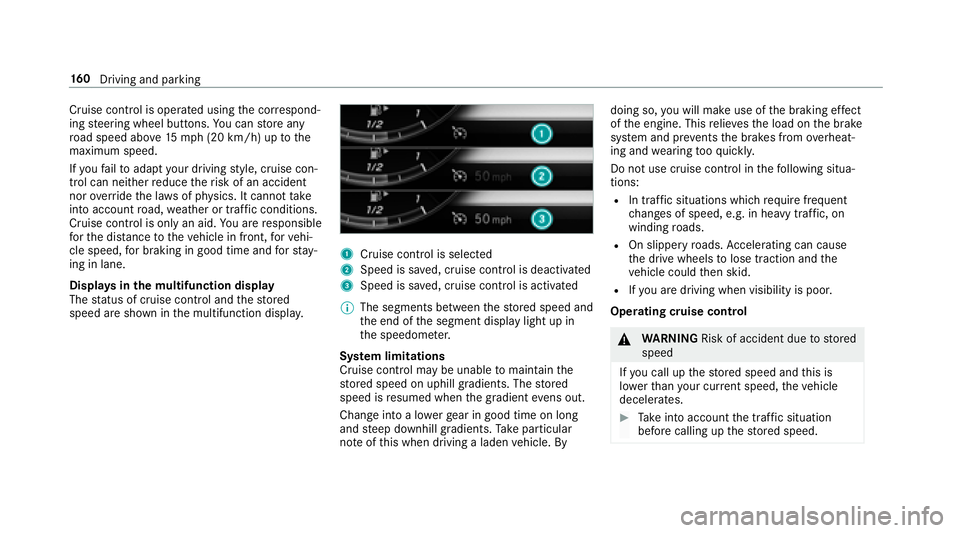
Cruise cont rol is operated using the cor respond‐
ing steering wheel buttons. You can store any
ro ad speed abo ve15 mp h (20 km/h) up tothe
maximum speed.
If yo ufa ilto adapt your drivin gst yle, cruise con‐
trol can neither reduce therisk of an accident
nor override the la wsof ph ysics. It cannot take
into account road, weather or traf fic conditions.
Cruise control is only an aid. You are responsible
fo rth e dis tance totheve hicle in front, forve hi‐
cle speed, for braking in good time and forst ay ‐
ing in lane.
Displa ysinthe multifunction display
The status of cruise control and thestored
speed are shown in the multifunction displa y.
1Cruise cont rol is selecte d
2Speed is sa ved, cruise control is deactivated
3Speed is sa ved, cruise control is activated
% The segments between thestored speed and
th e end of the segment display light up in
th e speedome ter.
Sy stem limitations
Cruise control may be unable tomaintain the
st ored speed on uphill gradients. The stored
speed is resumed when the gradient evens out.
Change into a lo werge ar in good time on long
and steep downhill gradients. Take particular
no te ofthis when driving a laden vehicle. By doing so,
youwill make use of the braking ef fect
of the engine. This relie vesth e load on the brake
sy stem and pr events the brakes from overheat‐
ing and wearing tooqu ickl y.
Do not use cruise control in thefo llowing situa‐
tions:
RIn traf fic situations whi chrequ ire frequent
ch anges of speed, e.g. in heavy traf fic, on
winding roads.
ROn slippery roads. Accelerating can cause
th e drive wheels tolose traction and the
ve hicle could then skid.
RIfyo u are driving when visibility is poor.
Ope rating cruise control
&
WARNING Risk of accident due tostored
speed
If yo u call up thestored speed and this is
lo we rth an your cur rent speed, theve hicle
decelerates.
#Ta ke into account the tra ffic situation
before calling up thestored speed.
16 0
Driving and pa rking
Page 163 of 502
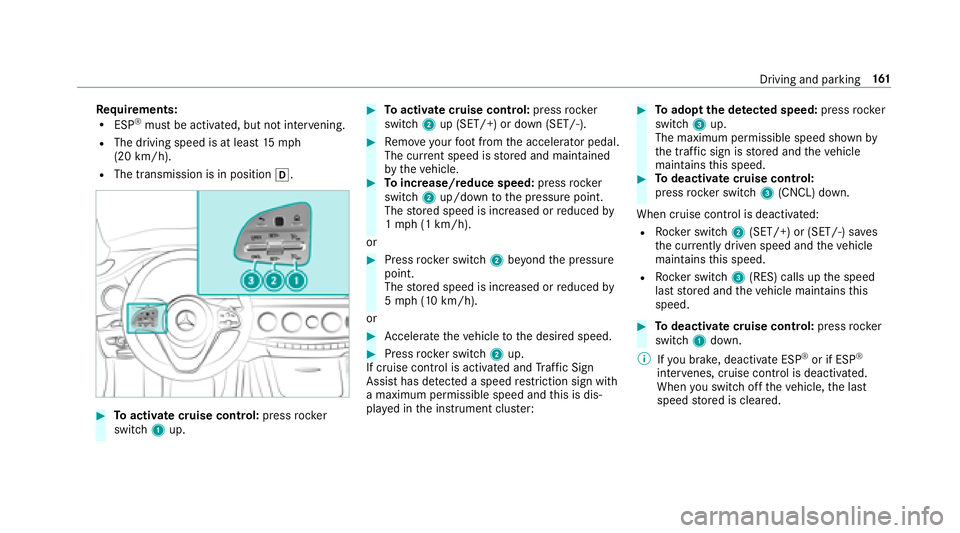
Requirements:RESP®must be activated, but not inter vening.
RThe driving speed is at least 15mp h
(20 km/h).
RThe transmission is in position h.
#Toactivate cruise control: pressrock er
switch 1up.
#Toactivate cruise control: pressrock er
switch 2up (SET/+) or down (SET/-).
#Remo veyour foot from the accelerator pedal.
The cur rent speed is stored and maintained
by theve hicle.
#To increase/reduce speed: pressrock er
switch 2up/down tothe pressure point.
The stored speed is increased or reduced by
1 mp h(1 km/h).
or
#Press rocker switch 2beyond the pressure
point.
The stored speed is increased or reduced by
5 mp h(1 0 km/h).
or
#Ac celerate theve hicle tothe desired speed.
#Press rocker switch 2up.
If cruise control is activated and Traf fic Sign
Assist has detected a speed restriction sign wi th
a maximum permissible speed and this is dis‐
pla yed in the instrument clus ter:
#To adopt the de tected speed: pressrocker
switch 3up.
The maximum permissible speed shown by
th e traf fic sign is stored and theve hicle
maintains this speed.
#To deactivate cruise control:
press rocker switch 3(CNCL) down.
When cruise control is deactivated:
RRo cker switch 2(SET/+) or (SET/-) sa ves
th e cur rently driven speed and theve hicle
maintains this speed.
RRo cker switch 3(RES) calls up the speed
last stored and theve hicle maintains this
speed.
#To deactivate cruise control: pressrock er
switch 1down.
% Ifyo u brake, deactivate ESP
®or if ESP®
inter venes, cruise control is deacti vated.
When youswit choff theve hicle, the last
speed stored is cleared.
Driving and parking 16
1
Page 164 of 502
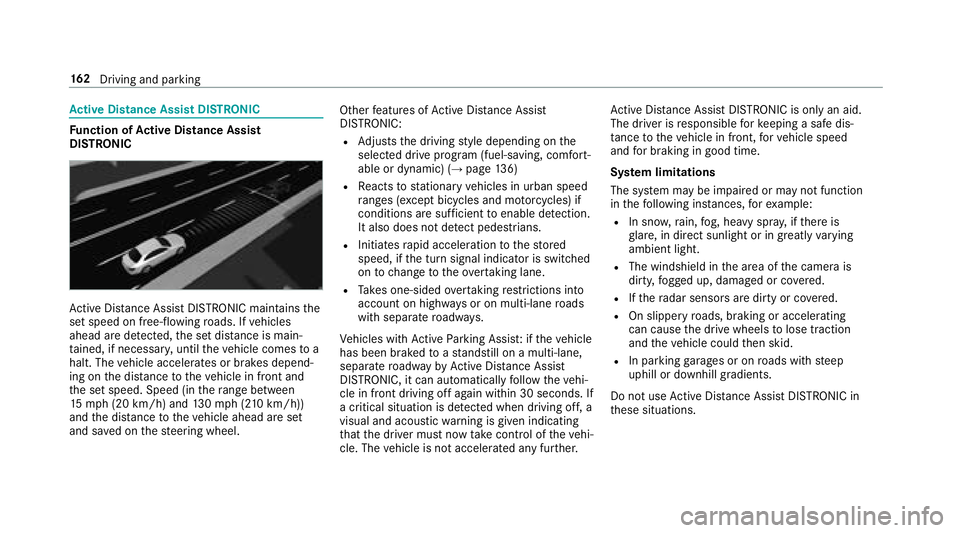
Active Di stance Assist DI STRONIC
Function of Active Di stance Assist
DI STRO NIC
Active Dis tance Assist DISTRONIC maintains the
set speed on free-flowing roads. If vehicles
ahead are de tected, the set dis tance is main‐
ta ined, if necessar y,unt ilth eve hicle comes toa
halt. The vehicle accelerates or brakes depend‐
ing on the dis tance totheve hicle in front and
th e set speed. Speed (in thera nge between
15 mp h(2 0 km/h) and 130mp h(210 km/h))
and the dis tance totheve hicle ahead are set
and sa ved on thesteering wheel. Other
features of Active Dis tance Assist
DISTRONIC:
RAd justs the driving style depending on the
selected drive program (fuel-saving, comfort‐
able or dynamic) (
→page 136)
RRe acts tostationary vehicles in urban speed
ra nges (e xcept bicycles and mo torcyc les) if
conditions are suf ficient toenable de tection.
It also does not de tect pedestrians.
RInitiates rapid acceleration tothestored
speed, if the turn signal indicator is switched
on tochange totheove rtaking lane.
RTa ke s one-sided overtaking restrictions into
account on highw ays or on multi-lane roads
with separate roadw ays.
Ve hicles with Active Parking Assis t:ifth eve hicle
has been braked toast andstill on a multi-lane,
separate roadw ay by Active Dis tance Assist
DISTRONIC, it can au tomatical lyfollow th
eve hi‐
cle in front driving off again within 30 seconds. If
a crit
ical situation is de tected when driving off, a
visual and acoustic warning is given indicating
th at the driver must now take control of theve hi‐
cle. The vehicle is not accelerated any fur ther. Ac
tive Dis tance Assist DISTRONIC is only an aid.
The driver is responsible forke eping a safe dis‐
ta nce totheve hicle in front, forve hicle speed
and for braking in good time.
Sy stem limitations
The sy stem may be impaired or may not function
in thefo llowing ins tances, forex ample:
RIn snow ,ra in, fog, heavy spr ay, if there is
gl are, in direct sunlight or in greatly varying
ambient light.
RThe windshield in the area of the camera is
dirty, fogged up, damaged or co vered.
RIfth era dar sensors are dirty or co vered.
ROn slippery roads, braking or accelerating
can cause the drive wheels tolose traction
and theve hicle could then skid.
RIn parking garage s or on roads with steep
uphill or downhill gradients.
Do not use Active Dis tance Assist DISTRONIC in
th ese situations.
16 2
Driving and pa rking
Page 165 of 502
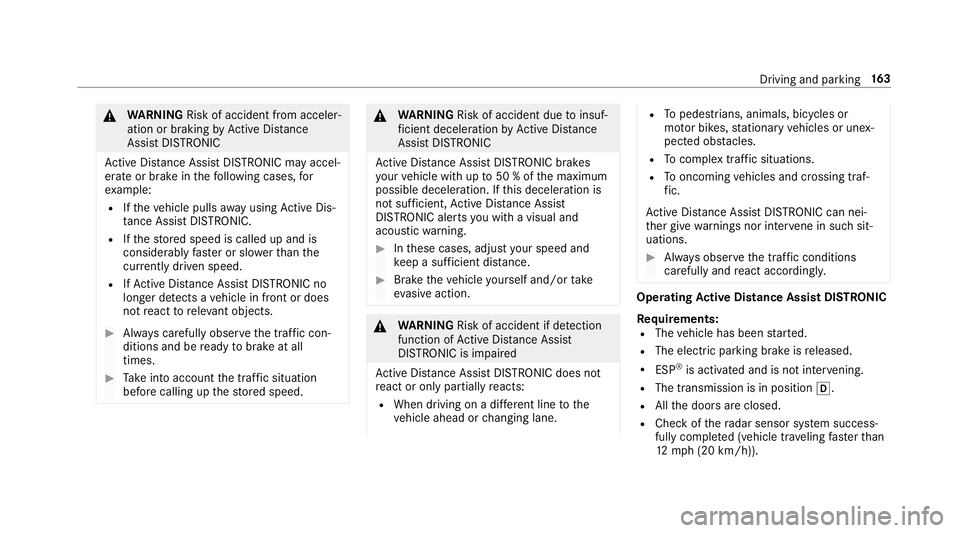
&WARNING Risk of accident from acceler‐
ation or braking byActive Dis tance
Assist DISTRONIC
Ac tive Dis tance Assist DISTRONIC may accel‐
erate or brake in thefo llowing cases, for
ex ample:
RIfth eve hicle pulls away using Active Dis‐
ta nce Assist DISTRONIC.
RIfth estored speed is called up and is
considerably faster or slo werth an the
cur rently driven speed.
RIfAc tive Dis tance Assist DISTRONIC no
longer de tects a vehicle in front or does
not react toreleva nt objects.
#Alw ays carefully obser vethe traf fic con‐
ditions and be ready tobrake at all
times.
#Ta ke into account the tra ffic situation
before calling up thestored speed.
&
WARNING Risk of accident due toinsuf‐
fi cient decele ration byActive Dis tance
Assist DISTRONIC
Ac tive Dis tance Assist DISTRONIC brakes
yo ur vehicle with up to50 % of the maximum
possible deceleration. If this decele ration is
not suff icient,Active Dis tance Assist
DISTRONIC alerts you with a visual and
acoustic warning.
#In these cases, adjust your speed and
ke ep a suf ficient dist ance.
#Braketheve hicle yourself and/or take
ev asive action.
&
WARNING Risk of accident if de tection
function of Active Dis tance Assist
DISTRONIC is impaire d
Ac tive Dis tance Assist DISTRONIC does not
re act or only pa rtially reacts:
RWhen driving on a dif fere nt line tothe
ve hicle ahead or changing lane.
RTo pedestrians, animals, bicycles or
mo tor bikes, stationary vehicles or unex‐
pected obs tacles.
RTo complex traffic situations.
RTo oncoming vehicles and crossing traf‐
fi c.
Ac tive Dis tance Assist DISTRONIC can nei‐
th er give warnings nor inter vene in such sit‐
uations.
#Alw ays obser vethe tra ffic conditions
carefully and react accordingl y.
OperatingActive Di stance Assist DI STRO NIC
Re quirements:
RThe vehicle has been star ted.
RThe elect ric park ing brake is released.
RESP®is activated and is not inter vening.
RThe transmission is in position h.
RAllthe doors are closed.
RCheck of thera dar sensor sy stem success‐
fully comple ted (vehicle tra veling fasterthan
12 mp h (20 km/h)).
Driving and parking 16
3
Page 166 of 502
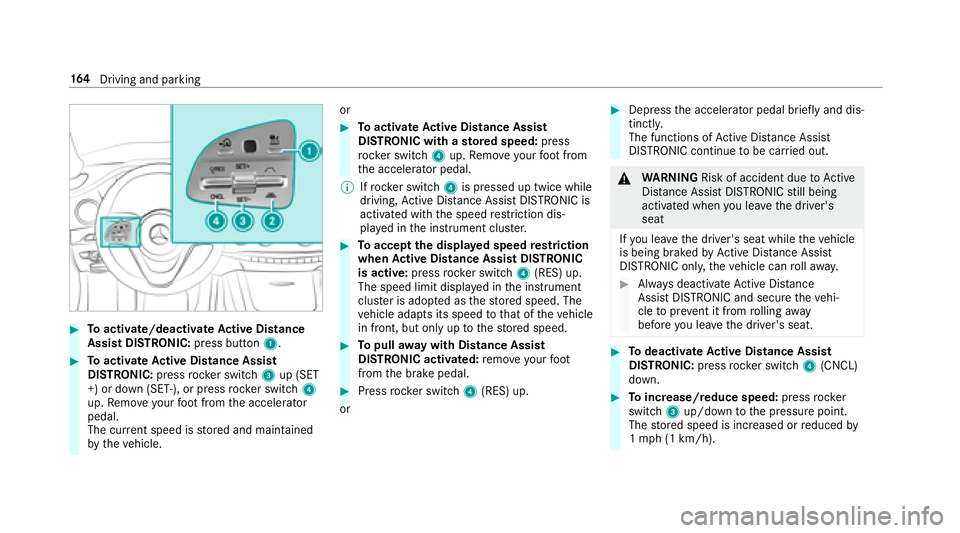
#Toactivate/deacti vate Active Di stance
Assist DI STRO NIC: press button 1.
#Toactivate Active Di stance Assist
DI STRO NIC:press rock er switch 3up (SET
+) or down (SET-), or press rocker switch 4
up. Remo veyour foot from the accelerator
pedal.
The cur rent speed is stored and maintained
by theve hicle. or
#To
activate Active Di stance Assist
DI STRO NIC with a stored speed: press
rock er switch 4up. Remo veyour foot from
th e accelerator pedal.
% Ifrock er switch 4is pressed up twice while
driving, Active Dis tance Assist DISTRONIC is
acti vated with the speed restriction dis‐
play ed in the instrument clus ter.
#To accept the displa yed speed restriction
when Active Di stance Assist DI STRONIC
is active: pressrocker switch 4(RES) up.
The speed limit displa yed in the instrument
clus ter is ado pted as thestored speed. The
ve hicle adapts its speed tothat of theve hicle
in front, but only up tothestored speed.
#To pull away wit hDistance Assis t
DISTRONIC activated: remo veyour foot
from the brake pedal.
#Press rocker switch 4(RES) up.
or
#Depress the accelerator pedal briefly and dis‐
tinctl y.
The functions of Active Dis tance Assist
DISTRONIC continue tobe car ried out.
&
WARNING Risk of accident due toActive
Dis tance Assist DISTRONIC still being
activated when you lea vethe driver's
seat
If yo u lea vethe driver's seat while theve hicle
is being braked byActive Dis tance Assist
DISTRONIC only, theve hicle can rollaw ay.
#Alw ays deactivate Active Dis tance
Assist DISTRONIC and secure theve hi‐
cle topreve nt it from rolling away
before you lea vethe driver's seat.
#To deactivate Active Di stance Assist
DI STRO NIC:press rock er switch 4(CNCL)
down.
#To increase/reduce speed: pressrock er
switch 3up/down tothe pressure point.
The stored speed is increased or reduced by
1 mp h(1 km/h).
16 4
Driving and pa rking
Page 167 of 502
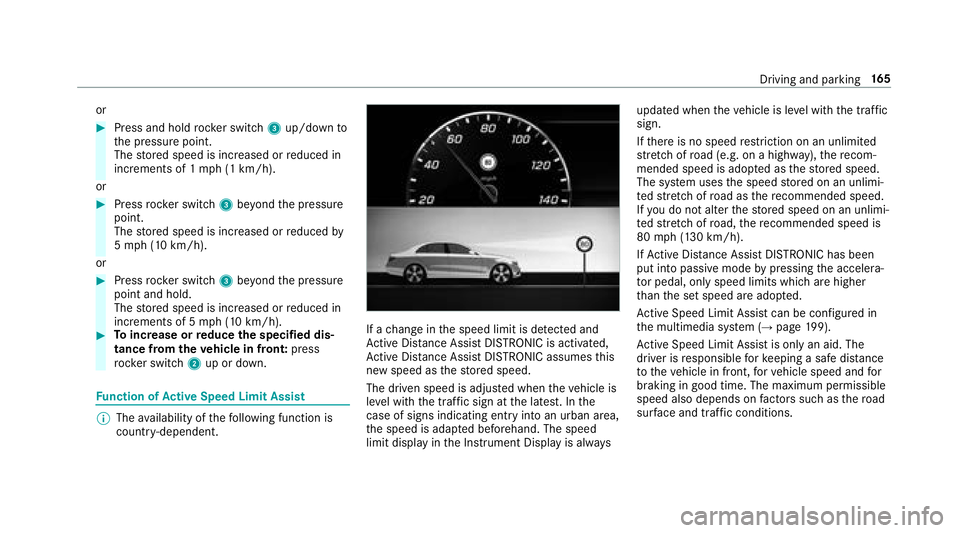
or
#Press and holdrocker switch 3up/down to
th e pressure point.
The stored speed is increased or reduced in
increments of 1 mph (1 km/h).
or
#Press rocker switch 3beyond the pressure
point.
The stored speed is increased or reduced by
5 mp h(1 0 km/h).
or
#Press rocker switch 3beyond the pressure
point and hold.
The stored speed is increased or reduced in
increments of 5 mph (10 km/h).
#Toincrease or reduce the speci fied dis‐
tance from theve hicle in front: press
rock er switch 2up or down.
Function of Active Speed Limit Assi st
%
The availability of thefo llowing function is
countr y-dependent.
If a change in the speed limit is de tected and
Ac tive Dis tance Assist DISTRONIC is acti vated,
Ac tive Dis tance Assist DISTRONIC assumes this
new speed as thestored speed.
The driven speed is adjus ted when theve hicle is
le ve l with the traf fic sign at the latest. In the
case of signs indicating entry into an urban area,
th e speed is adap ted beforehand. The speed
limit display in the Instrument Display is alw ays updated when
theve hicle is le vel with the tra ffic
sign.
If th ere is no speed restriction on an unlimi ted
st re tch of road (e.g. on a highwa y),there com‐
mended speed is adop ted as thestored speed.
The sy stem uses the speed stored on an unlimi‐
te dstre tch of road as there commended speed.
If yo u do not alter thestored speed on an unlimi‐
te dstre tch of road, there commended speed is
80 mph (130 km/h).
If Ac tive Dis tance Assist DISTRONIC has been
put into passive modebypressing the accelera‐
to r pedal, only speed limits which are higher
th an the set speed are adop ted.
Ac tive Speed Limit Assi stcan be configu red in
th e multimedia sy stem (→page 199).
Ac tive Speed Limit Assi stis only an aid. The
driver is responsible forke eping a saf e dis
tance
to theve hicle in front, forve hicle speed and for
brak
ing in good time. The maximum permissible
speed also depends on factors such asthero ad
sur face and traf fic conditions.
Driving and park ing16
5
Page 168 of 502
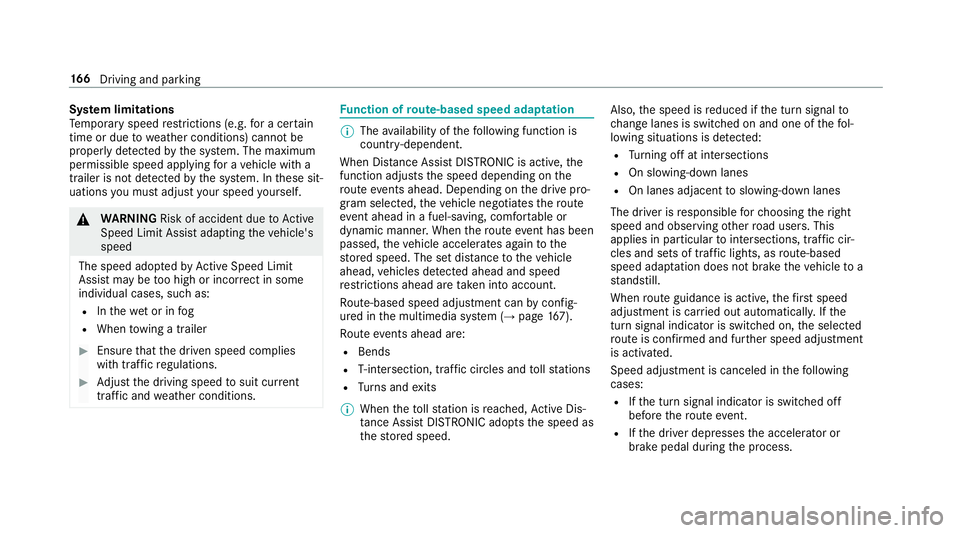
System limitations
Te mp orary speed restrictions (e.g. for a cer tain
time or due towe ather conditions) cannot be
proper lyde tected bythe sy stem. The maximum
permissible speed applying for a vehicle with a
trailer is not de tected bythe sy stem. In these sit‐
uations you must adjust your speed yourself.
&
WARNING Risk of accident due toActive
Speed Limit Assi stadapting theve hicle's
speed
The speed adop tedby Active Speed Limit
Assi stmay be too high or incor rect in some
individual cases, such as:
RInthewe t or in fog
RWhen towing a trailer
#Ensure that the driven speed complies
with traf fic re gulations.
#Ad just the driving speed tosuit cur rent
traf fic and weather conditions.
Function of route-based speed adaptation
%
The availability of thefo llowing function is
countr y-dependent.
When Dis tance Assist DISTRONIC is acti ve,th e
function adju ststh e speed depending on the
ro ute events ahead. Depending on the drive pro‐
gram selected, theve hicle negotiates thero ute
eve nt ahead in a fuel-s aving, com fortable or
dynamic manner. When thero ute event has been
passed, theve hicle accelerates again tothe
st ored speed. The set dis tancetotheve hicle
ahead, vehicles de tected ahead and speed
re strictions ahead are take n into account.
Ro ute-based speed adjustment can byconfig‐
ured in the multimedia sy stem (
→page 167).
Ro ute events ahead are:
RBends
RT-intersection, traf fic circles and tollst ations
RTu rns and exits
% When theto llst ation is reached, Active Dis‐
ta nce Assist DISTRONIC adopts the speed as
th estored speed. Also,
the speed is reduced if the turn signal to
ch ange lanes is switch ed on and one ofthefo l‐
lowing situations is de tected:
RTu rning off at intersections
ROn slowing-down lanes
ROn lanes adjacent toslowing-down lanes
The driver is responsible forch oosing theright
speed and observing other road users. This
applies in particular tointersections, traf fic cir‐
cles and sets of traf fic lights, as route-based
speed adap tati
on does not brake theve hicle toa
st andstill.
When route guidance isactive, thefirs t speed
adjustment is car ried out automatically. If the
turn signal indica tor is switched on, the selected
ro ute isconfirmed and fur ther speed adjustment
is activated.
Speed adjustment is canceled in thefo llowing
cases:
RIf th e turn signal indicator is switched off
before thero ute event.
RIfth e driver depresses the accelera tor or
brake pedal during the process.
16 6
Driving and pa rking
Page 169 of 502
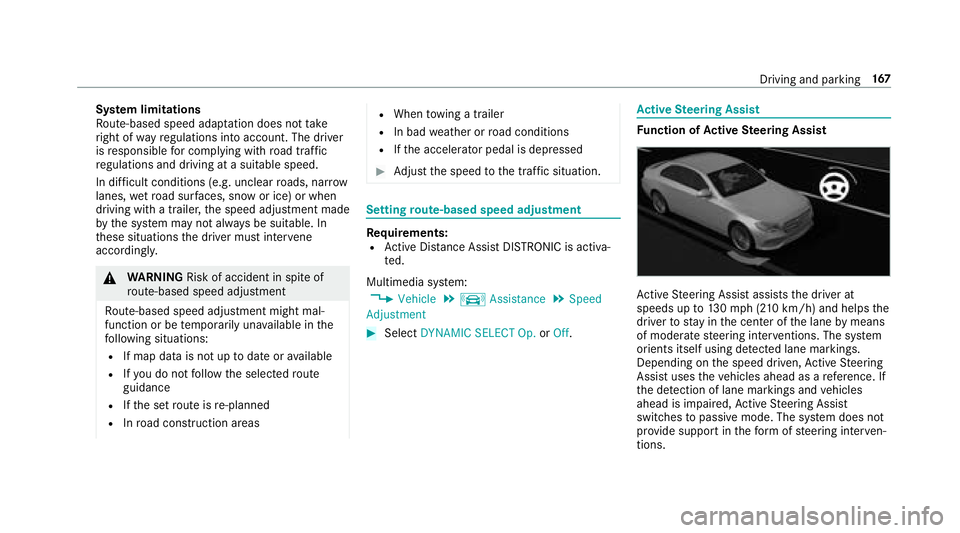
System limitations
Ro ute-based speed adap tation does not take
ri ght of wayre gulations into account. The driver
is responsible for complying with road traf fic
re gulations and driving at a suitable speed.
In dif ficult conditions (e.g. unclear roads, nar row
lanes, wetro ad sur faces, snow or ice) or when
driving wi tha trailer, the speed adjustment made
by the sy stem may not alw ays be suitable. In
th ese situations the driver must inter vene
acco rdingly.
&
WARNING Risk of accident in spite of
ro ute-based speed adjustment
Ro ute-based speed adjustment might mal‐
function or betemp orarily una vailable in the
fo llowing situations:
RIf map data is not up todate or available
RIfyo udo not follow the selected route
guidance
RIf th e set route isre-planned
RIn road con stru ction areas
RWhen towing a trailer
RIn bad weather or road conditions
RIfth e accelerator pedal is depressed
#Ad just the speed tothe traf fic situation.
Setting route-based speed adjustment
Re quirements:RActive Dis tance Assist DISTRONIC is acti va‐
te d.
Multimedia sy stem:
,Vehicle.k Assistance.Speed
Adjustment
#Select DYNAMIC SELECT Op. orOff.
Ac tive Steering Assist
Function of Active Steering Assist
Active Steering Assist assists the driver at
speeds up to130mp h (2 10km/h) and helps the
driver tostay inthe center of the lane bymeans
of moderate steering inter ventions. The sy stem
orients itself using de tected lane markings.
Depending on the speed driven, Active Steering
Assist uses theve hicles ahead as a refere nce. If
th e de tection of lane markings and vehicles
ahead is impaired, Active Steering Assist
switches topassive mode. The sy stem does not
pr ov ide support in thefo rm ofsteering inter ven‐
tions.
Driving and pa rking 16
7
Page 170 of 502
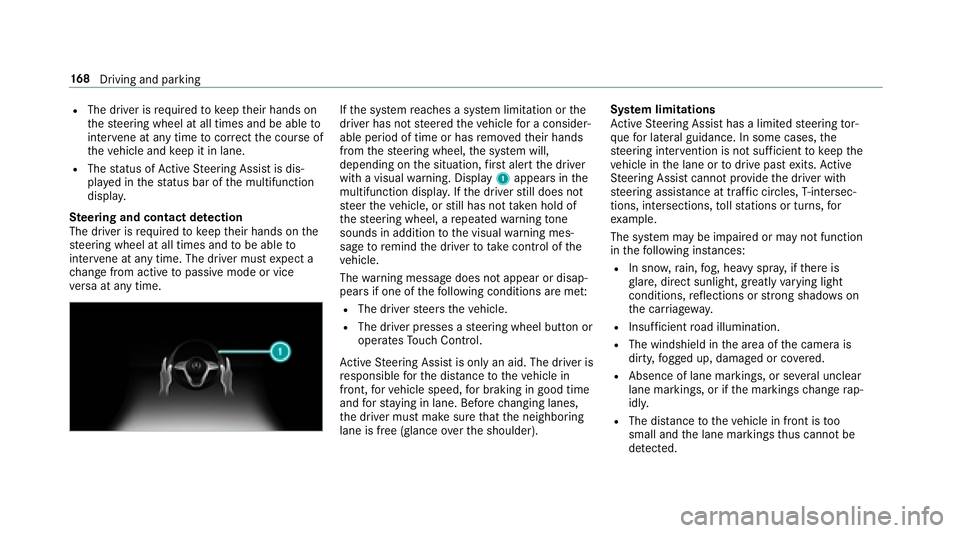
RThe driver isrequ ired tokeep their hands on
th esteering wheel at all times and be able to
inter vene at any time tocor rect the course of
th eve hicle and keep it in lane.
RThe status of Active Steering Assist is dis‐
pla yed in thest atus bar of the multifunction
displa y.
Ste ering and contact de tection
The driver is requ ired tokeep their hands on the
st eering wheel at all times and tobe able to
inter vene at any time. The driver must expect a
ch ange from active topassive mode or vice
ve rsa at any time.
If th e sy stem reaches a sy stem limitation or the
driver has not steered theve hicle for a consider‐
able period of time or has remo vedth eir hands
from thesteering wheel, the sy stem will,
depending on the situation, firs t alert the driver
with a visual warning. Display 1appears in the
multifunction displa y.Ifth e driver still does not
st eer theve hicle, or still has not take n hold of
th esteering wheel, a repeated warning tone
sounds in addition tothe visual warning mes‐
sage toremind the driver totake control of the
ve hicle.
The warning message does not appear or disap‐
pears if one of thefo llowing conditions are me t:
RThe driversteers theve hicle.
RThe driver presses a steering wheel button or
operates Touch Control.
Ac tive Steering Assist is only an aid. The driver is
re sponsible forth e dis tance totheve hicle in
front, forve hicle speed, for braking in good time
and forst ay ing in lane. Before changing lanes,
th e driver must make sure that the neighboring
lane is free (glance over the shoulder). Sy
stem limitations
Ac tive Steering Assist has a limited steering tor‐
qu efo r lateral guidance. In some cases, the
st eering inter vention is not suff icienttokeep the
ve hicle in the lane or
todrive past exit
s.Ac tive
St eering Assist cann otprov ide the driver with
st eering assis tance at traf fic circles, T-intersec‐
tions, intersections, tollst ations or turns, for
ex ample.
The sy stem may be impaired or may not function
in thefo llowing ins tances:
RIn sno w,rain, fog, heavy spr ay, if there is
gl are, direct sunlight, greatlyvarying light
conditions, reflections or stro ng shado wson
th e car riag ew ay.
RInsuf ficient road illumination.
RThe windshield in the area of the camera is
dirty, fogged up, damaged or co vered.
RAb sence of lane markings, or se veral unclear
lane markings, or if the markings change rap‐
idly.
RThe dis tance totheve hicle in front is too
small and the lane markings thus cannot be
de tected.
16 8
Driving and pa rking